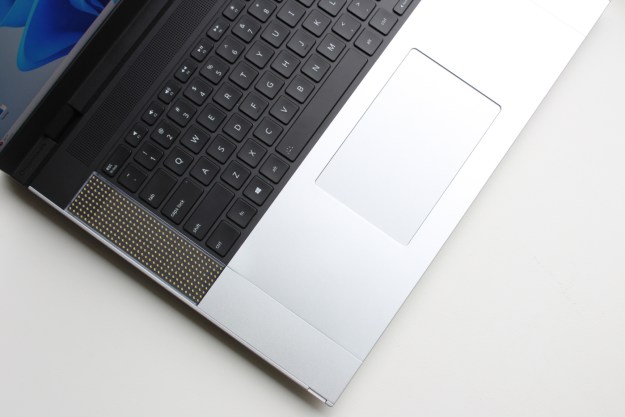
- Upgradable graphics!
- Intuitive, tool-less modularity
- Well-balanced IPS display
- Ports galore
- Solid performance
- Customization for days
- Decent battery life
- Bulky and heavy
- Some components feel awkward and cheap
- Mushy keyboard
Never heard of Framework? That’s fair. The four-year-old company has released just one other product, the Framework Laptop 13. I loved the initial concept behind this device: nearly every component can be swapped out, replaced, and upgraded. That includes not just basic stuff, like the memory and storage, but even the battery, motherboard, and CPU. You could even mix and match which ports were connected.
The sequel, the Framework Laptop 16, takes that customization and modularity to a whole new level. Now, it’s not just the internals that can be modified – but even the keyboard, touchpad, and periphery add-ons to the keyboard deck. The ability to swap out the discrete GPU is what really has people excited, though. Is it worth the hype? In most ways, yes — even if there are times I wonder whether some of the modularity is as useful as it purports to be.
Modular design
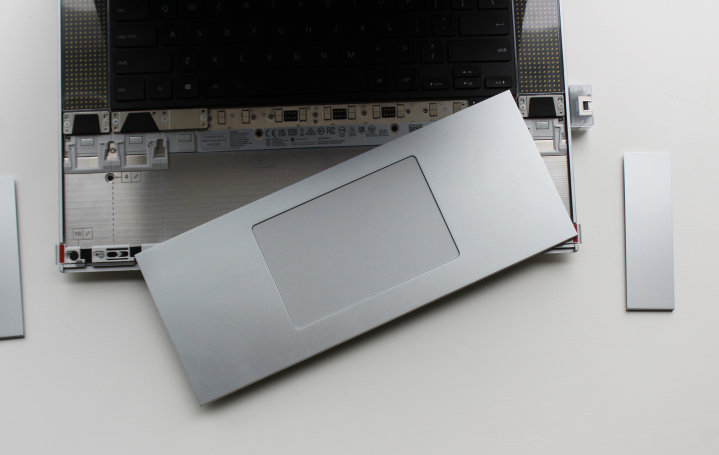
While the Framework Laptop 13 looks like any other laptop on the outside, the Framework Laptop 16 makes its approach to modularity more apparent and outwardly visible. The entire layout of the keyboard and touchpad can be rearranged using a variety of spacers and input modules – all without needing a single screw. Even the keyboard and touchpad are held together just using magnets and clips. It all connects together far better than I even hoped.
You might wonder: What arrangements would you want to use besides a standard layout? Well, for example, you might want a number pad to slide in to the right of the keyboard. Or why not try out the RGB MacroPad for custom lighting and programmable macros? You can then move the touchpad over to be centered under the spacebar. Or, if you have the keyboard centered, you can slide in an LED matrix or some solid-colored spacers. It’s gadgety and customizable in a way that tech rarely is these days.
There are some downsides, though. The simple silver spacers on the palm rests are kind of an eyesore, and the seams are distracting. I wish Framework somehow could have offered a standard option that stretched the full width of the palm rests.
Meanwhile, if you opt for the LED matrix next to the keyboard, the plastic covers feel a bit fragile. They’re neat and purely for fun, but are cheap-feeling. The result is that everything has a bit too much give, which makes sense for how many moving parts there are, but it is not ideal for a premium laptop. I’d probably swap them out for a couple of black spacers on my own unit.
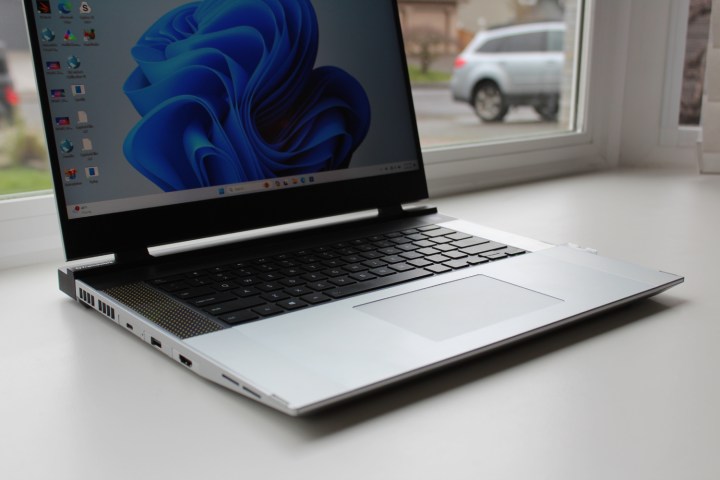
The other downside of the modularity is that the keyboard is a bit mushy to type on. It says there’s 1.5mm of travel, but there’s a lack of precision in the keypresses, especially compared to the Framework Laptop 13. Don’t get me wrong – I’m amazed they were able to include a usable keyboard without a single ribbon or cable. But it’s just not the most enjoyable to use.
Sidenote: the RGB backlighting is great, and you can even enhance the aesthetic with clear keycaps – which I didn’t get to try – but they look stellar.
All the moving parts are inarguably neat, but at this point, the modularity is less about sustainability or longevity and more about customization. You can make this what you want, but I can’t see someone actually reverting changes to the layout once they have it set. Unlike the Expansion Slots (ports) or upgrading the internals, a person’s need for certain inputs likely won’t change over time. It’s fun to play around with different spacers, but I’d far prefer to pick the layout I want at the time of purchase – or trade out an LED matrix for some better, upward-firing speakers, for that matter.
Look and feel
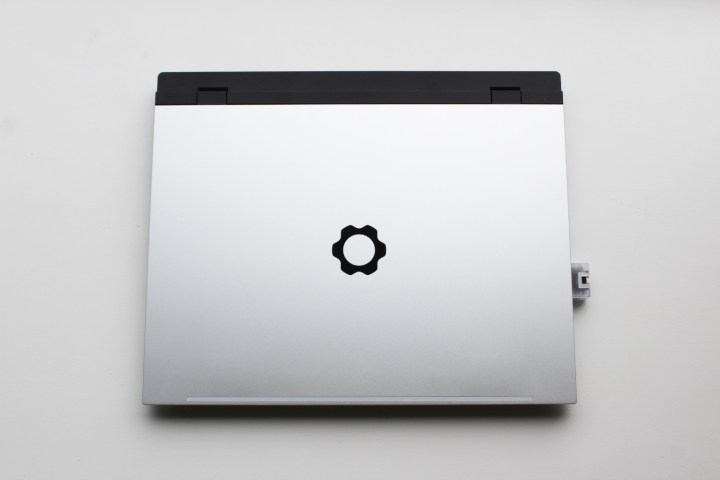
Once you have everything in place, there’s a lot about the look of the Framework Laptop 16 that I adore. The dual-tone silver and black pairing has become a trendy design flourish thanks to the MacBook Pro, and the Framework Laptop 16 pulls it off in a unique way. It takes inspiration from Apple, but using black along the Graphics Module (or thermal shelf, as other designs call it) and under the display adds some additional differentiation, as does the per-key RGB backlighting. That’s certainly something you won’t find on a MacBook.
Upon pulling the Framework Laptop 16 out of its box, I was disappointed to see just how thick and bulky it was. That’s because my unit came with the Radeon RX 7700S Graphics Module already installed, which is one of the laptop’s most unique features. The ability to only go from integrated graphics to discrete feels like magic, requiring just a few screws. This is something PC enthusiasts have wanted forever because not only can you switch back and forth, but you can also upgrade to future generations of GPUs. More on that later, but suffice to say that the Framework Laptop 16’s ability to upgrade GPUs is a big deal.
It doesn’t come without some compromises, though. The graphics module adds an extra 0.12 inches to the device’s thickness and over a half pound – an extra 0.66 pounds, to be exact, bringing it up to 5.29 pounds with the graphics installed.

The Graphics Module also makes the Framework Laptop 16 deeper, now 11.43 inches. But here’s the thing – it’s already a very deep laptop. In fact, it’s one of the deepest 16-inch
It’s a chunker, especially for a laptop not marketed for gaming. Throw that Graphics Module on, though, and it’s not so dissimilar in feel from an Alienware or Legion gaming laptop. And maybe that was the idea. After all, I can’t imagine someone buying just the “Expansion Bay Shell,” which is limited to integrated graphics. It makes for a prettier and more portable laptop, but you buy a laptop like this for the extra performance, whether for gaming or content creation — or both.
Ports
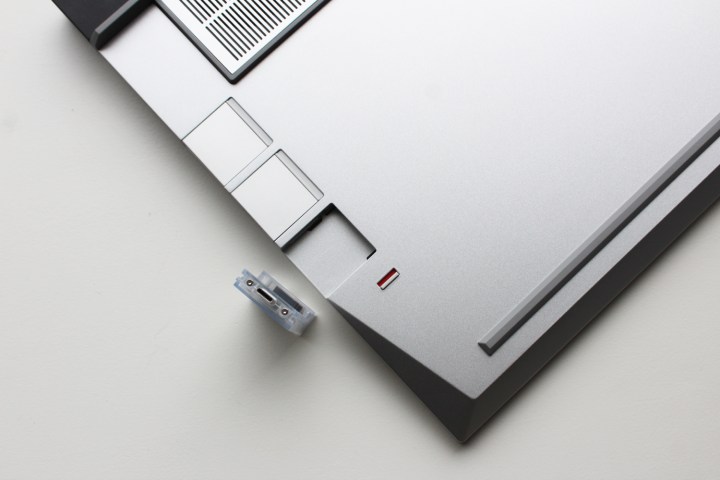
The Framework Laptop 16 gives you just about any port you could want in whatever arrangement you would want. Like the Framework Laptop 13, you can switch out the ports as you please using the Expansion Cards. You have six instead of four this time in addition to the USB-C on the rear for power delivery. These include USB-C, USB-A, HDMI, DisplayPort, Ethernet, MicroSD, a 3.5mm audio jack, or extra storage (250GB or 1TB).
Six feels like a good amount for this type of laptop, allowing you to include a little of everything. The Ethernet slot is the only one that awkwardly protrudes from the chassis.
Unfortunately, a full-size SD card slot wasn’t included in my bundle, which feels even more important on this more high-powered machine that might be used more for photo or video editing. It does say in the Framework Marketplace that an SD Expansion Card is coming soon, but it’s not currently available.
Performance
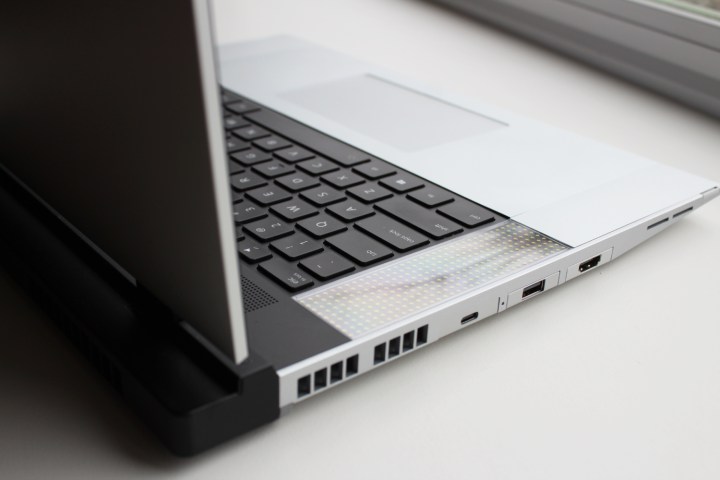
The main point of the Framework Laptop 16 over the 13-inch model is the performance improvement – specifically, modular GPU performance. Not only do you get an option for discrete graphics in the form of the Radeon RX 7700S, but it also comes with a more powerful Ryzen 7 7840HS processor — a big step up from what was offered in the Framework Laptop 13. There’s even an option to configure it with the slightly faster Ryzen 9 7940HS.
While the RX 7700S is the only discrete graphics option currently available, the great promise of Framework’s philosophy (and business model) is to continue supporting the laptop with future upgrades. So, in theory, when the next-gen Radeon graphics come out, you can upgrade your Framework Laptop 16’s graphics without replacing your entire laptop.
This was my first time testing this particular GPU, and I was pleased by what I saw. It landed around the level of a mobile RTX 4060, and Framework charges an extra $400 for the jump from integrated graphics. That sounds expensive, but it’s not overpriced for the uplift that’s provided.
The Framework Laptop 16 performs well but isn’t the best value based on that alone.
For reference, Dell charges $600 to go from the base configuration up to an RTX 4060 on the XPS 15. This price is important to keep in mind, too, since it gives a good estimate for at least how much Framework will charge for later GPU upgrades. We don’t know that official price yet, of course, nor do we know if Framework will support more powerful GPUs in the future. Given the USB-C charging, we can assume we may not get the RTX 4080 as an upgrade option.
It’s also important to keep in mind that you can buy much cheaper
| Geekbench 6 (single/multi) |
Handbrake (seconds) |
3DMark Time Spy | |
| Framework Laptop 16 (Ryzen 7 7840HS / RX 7700S) |
2470 / 11484 | 72 | 9436 |
| Lenovo Legion Pro 7i (Core i9-13900HX / RTX 4080) | 2020 / 19041 | 55 | 12874 |
| Lenovo ThinkPad Z16 Gen 2 (Ryzen 9 7940HS / RX 6550M) | 2200 / 8920 | 72 | 4776 |
| Acer Swift X 16 (Ryzen 7 7940HS / RTX 4050) | 2423 / 12108 | 64 | 7992 |
| Asus ROG Strix G17 (Ryzen 9 7845HX / RTX 4060) | 2796 / 13795 | 44 | 10188 |
Because as admirably as the Framework Laptop 16 performs, it will never be a good value based on that alone. The good news is that the Framework Laptop 16 is quite fast.
Game performance is really solid. For starters, 3DMark Time Spy put up some impressive numbers, comparing strongly against
I also tested
Internal modularity
It’s not just the GPU that can be upgraded, of course. Like the Framework Laptop 13, every major component of the 16-inch model can be accessed and removed. Nothing is soldered down, and everything can be easily removed following Framework’s excellent step-by-step guides. There’s nothing new here, so it’d be easy enough to skip over. The only difference is that you have to remove a midplate under the keyboard to access the internals.
But Framework’s approach still feels like a legitimate disruption to how the rest of the industry is heading. While gaming laptops tend to be better about allowing upgrades to memory and storage,
With the Framework Laptop 16, all that is out of the way and even easier than on other
For a powerful laptop, the ability to replace the battery, in particular, feels important. We’ve all heard horror stories about melting batteries in
I should also note that my model was the prebuilt configuration, which includes all the components. It’s more expensive, though, starting at $1,699, while mine was configured at $2,099. You can save a few hundred bucks by opting for the DIY Edition, which requires you to build it yourself and bring your own operating system, which Linux users will love.
Display
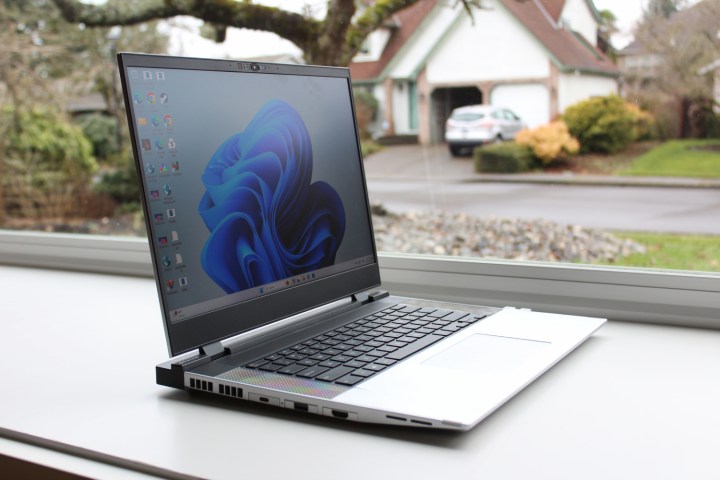
The Framework Laptop 16 has a 2560 x 1600 resolution IPS display with a refresh rate of 165Hz. From the specs alone, that’s solid. Given that there is just a single display option, that’s not a bad choice. It’s sharp enough for non-gaming and fast enough for gaming. And given the price as the display that comes standard, it’s not a bad value either.
That being said, for a device pushing customization and choice, only offering a single display option feels like a limitation. After all, most
I’m happy to report that the panel looks quite good otherwise. The contrast and color accuracy can’t compare to OLED panels, of course, nor can it compete with the brightness of mini-LED. But topping off at 484 nits is plenty bright for almost every situation imaginable, including working near a window or even outside. Color coverage is solid, too, hitting 100% of sRGB, 97% of P3, and 86% of the AdobeRGB color space.
Cameras and audio
The Framework Laptop 16 has a 1080p 60 fps webcam located above the screen in the top bezel, and the quality is solid. It’s certainly good enough for the occasional Zoom or Teams call. It has a physical camera shutter to cover the camera if you desire.
The laptop doesn’t include a Windows Hello IR camera but supplements the security hole with a fingerprint reader built into the power button. It was both fast and accurate while logging into Windows in my testing.
The speakers aren’t great, though. They’re only stereo and don’t offer a full sound for watching movies, listening to music, or playing games. Compared to other
Battery
The Framework Laptop 16 uses an 85-watt-hour battery, juiced up by the included 180-watt power adapter. It’s a surprisingly small and light adapter for a laptop of this kind — which is important for a laptop that’s already this heavy.
With the Graphics Module installed, the Framework Laptop 16 can last up to eight hours and 46 minutes on a fairly light load, cycling through heavy websites in a macro in Google Chrome. That’s pretty impressive for a larger laptop, especially since you can pull out the Graphics Module and gain even more. It’ll never be an all-day work laptop, but you’ll certainly be able to last a few hours away from an outlet without too much worry.
Was this a good idea?

I don’t know if Framework’s approach will ever catch on fully. But the more products the company makes, the more I hope it does.
The Framework Laptop 16 is a far bolder statement than the 13-inch model even was. And the question I keep coming back to is whether it was a good idea in the end. When it comes to the Graphics Module — absolutely. There’s no question about it, so long as the Framework Marketplace continues to offer GPU updates down the line and they don’t get too expensive. Upgrading your GPU every few years makes even more sense than upgrading the entire Mainboard of the Framework Laptop 13, especially since the price of those was as much as a new laptop in some cases.
Now that we’ve seen a second laptop in the line and a few years of support through the Framework Marketplace, I feel more comfortable recommending these
I question some of the choices around using spacers on the palm rest or the quality of the keyboard and touchpad. The neat thing is that some of these components could get replaced with something better in the future. That’s the beauty of complete modularity. Not every experiment has to go exactly right the first time.
Editors' Recommendations
- 9 best 2-in-1 laptops in 2024: tested and reviewed
- Best 14-inch laptops for 2024: tested and reviewed
- Best Buy deals: Save on laptops, TVs, appliances, and more
- Acer gets serious about 14-inch gaming laptops
- Best laptop deals: Save on the Dell XPS 14, MacBook Pro 16 and more



